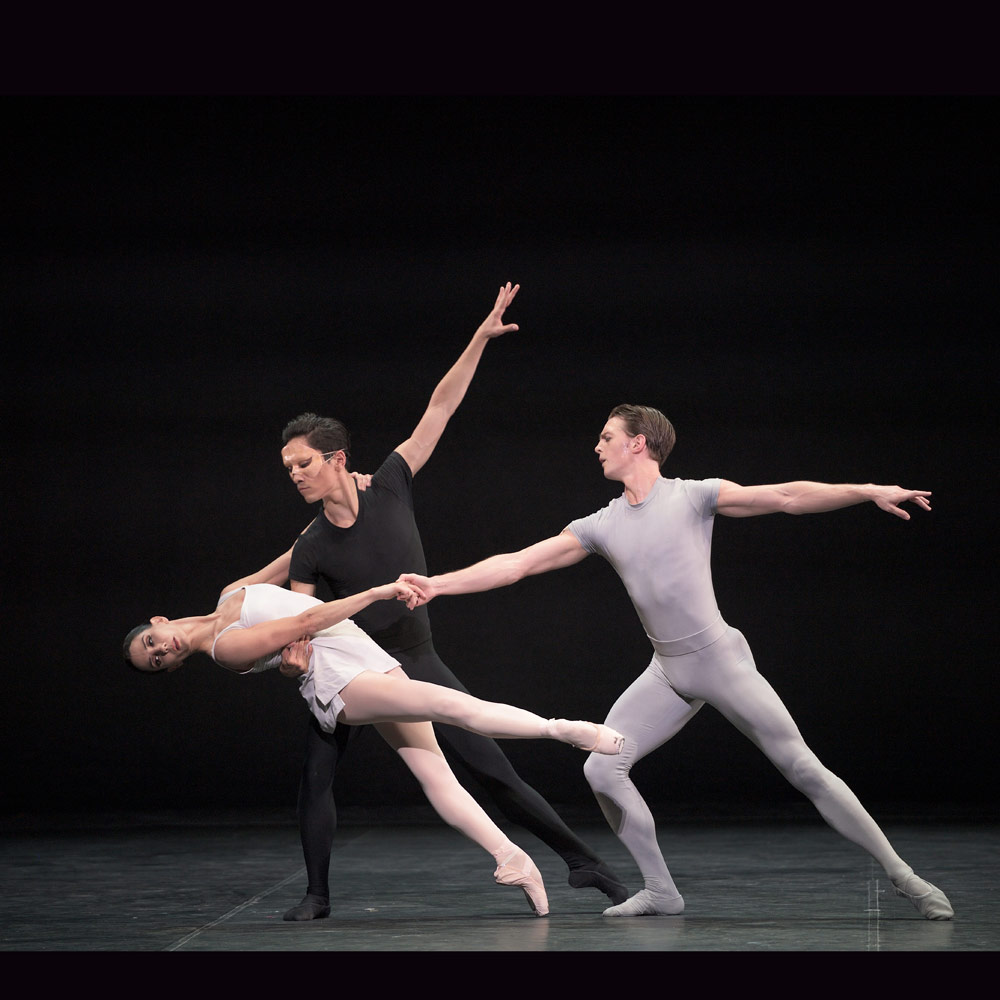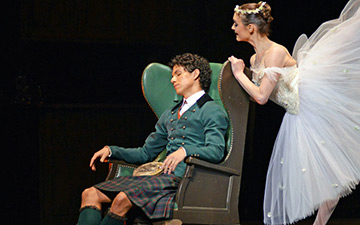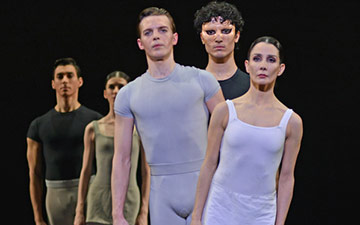
© Laurent Liotardo. (Click image for larger version)
English National Ballet
Song of the Earth, La Sylphide
★★★★✰
Manchester, Palace Theatre
11 October 2017
www.ballet.org.uk
Artistically, it was a low risk start to the English National Ballet’s touring season, presenting two classic ballets, created with more than a century between them, and with a combined performance history of almost 250 years. Commercially, however, it was nonetheless a tough sell to Mancunians since this opening night was far from a full house: a pity because this diverse programme was thoroughly enjoyable.
Song of the Earth is ENB’s contribution to the celebrations that mark the twenty-fifth anniversary of Sir Kenneth MacMillan’s passing and, in the 50+ years that have elapsed since it was created, it has continued to grow as a masterpiece; ironic, since The Royal Opera House turned down MacMillan’s request to choreograph Mahler’s powerful song cycle on the grounds that it was a musical masterpiece unsuited to dance. It seems to me that just as Mahler appropriated eighth-century Chinese poetry upon which to make incredible music; so, MacMillan used that music to make incredible dance. Undeterred he made Song of the Earth anyway, suggesting it as a commission to his friend, John Cranko, then director of the Stuttgart Ballet. It was such a success that The Royal Ballet adopted it as their own, six months after the world premiere.

© Laurent Liotardo. (Click image for larger version)
There are many thematic trends to MacMillan’s repertoire and one such is his intuitive ability to make dance connect to songs, in the most emotional way. Song of the Earth (1965) was the first, but later came Requiem (1976), as a tribute to Cranko who had died in 1973, and Gloria (1980); a trio of the most moving combinations of dance and song imaginable. Song of the Earth is actually six songs, the last of which (The Farewell) is about as long as the other five, collectively. Songs alternate between a Tenor (Samuel Sakker) and a Contralto (Rhonda Brown), who stand, respectively, to the left and right of the stage (but never together). It was glorious singing, although occasionally – perhaps due to the theatre’s acoustics – underpowered from the right flank. The ENB Philharmonic, conducted by Gavin Sutherland, was magnificent.
Three main figures dominate proceedings: a man (here, Joseph Caley), a woman (Tamara Rojo) and the Messenger of Death (Jeffrey Cirio). The programme noted that it was each dancer’s debut in the role, surprising news given that Rojo was such a sublime interpreter of the woman during her years with The Royal Ballet. Nothing much has changed and she is still completely absorbed in the music throughout, essaying a melancholic and beguiling loneliness in the second song (Autumn Solitude) and bringing the intense poetry of the final song achingly into being. It is a role full of technical challenges and Rojo meets them all, perhaps only showing a slight human frailty in the long, sustained pas de bourrées, just before the end, which were perhaps a little too staccato to give the desired impression of gliding over the stage.

© Laurent Liotardo. (Click image for larger version)
Caley brought a sensitive portrayal to his debut as the man and Cirio was a mysterious harbinger of the idea of death, continually haunting events, whether joyful or sad both as participant and observer; and appearing sinisterly at the end of most songs. Together, this trio brought the ballet to a mesmerising conclusion with their long, undulating, and painfully slow journey downstage.
There was tremendous support from the other dancers, notably by Senri Kou who is manipulated and passed around the male dancers, largely upside-down, in the third song (Of Youth) representing her reflection in the waters of a lake, with all of the dancers repeating this imagery at the close of the song; and the strong pairing of Tiffany Hedman and Aitor Arrieta to lead the fourth song (Of Beauty) in which Hedman essays an aching and fluid performance of the main solo.
All-in-all this was a breath-taking performance save for the general observation that the dancers need to work harder at controlling their breathing and facial movements when standing still, in pose. It is a little distracting.
The ENB production of La Sylphide has been staged by three luminaries of Danish ballet, Frank Andersen, Eva Kloborg and Anne Marie Vessel Schlüter, and is, therefore, one supposes, as authentic to the August Bournonville ideals, as possible after the passage of 180 years. It certainly delves into new-old territory that is unchartered, at least for me; for example, by naming James’s friends, Bimse and Bumse, played by Fabian Reimar and, especially, James Streeter as if extras in “Carry on Up the Highlands”!

© Laurent Liotardo. (Click image for larger version)
As James, Isaac Hernandez showed yet another aspect to his versatility with a fine demonstration of Bournonville style and an excellent characterisation of the lost boy being seduced from the real world into ethereality. His Sylph was Jurgita Dronina who danced serenely and gave an effective portrait of the woodland fairy inquisitively exploring the human world and finding love. Jane Howarth was terrific as a sometimes brooding, sometimes manic, Madge, the witch spurned by James and determined to bring him down; Anjuli Hudson was the bright-eyed highland lassie betrayed by James and Giorgio Garrett the morose highland hunk whom she accepted as an alternative bridegroom. Stina Quagebeur, Maria José Sales and Precious Adams shone amongst an excellent kilted ensemble.
Although La Sylphide is a ballet with a distinctly unhappy ending, it always seems such fun to get there; and although Manchester is a long way from London, solely to spend an evening at the ballet, it was well worth going.

















You must be logged in to post a comment.